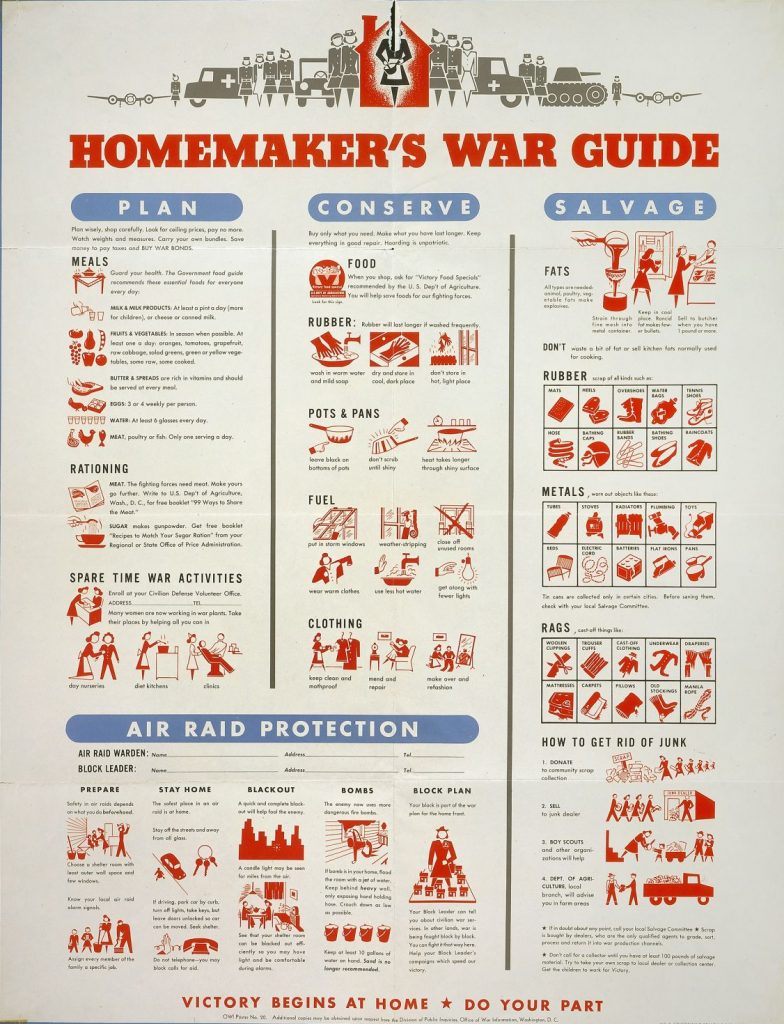Background
In 1944, Eleanor Roosevelt wrote in Readers’ Digest, a popular national magazine, that women “running their houses quietly and efficiently are contributing more to the war effort than they themselves realize.” Housewives were the first line of defense in the war against waste. Metal, rubber, fuel, textiles, meat, and other foods were needed to maintain America’s massive military. Before the war, conserving resources and carefully planning budgets were the characteristics of an expert housewife. During the war, these activities were acts of patriotism.
Housewives were also expected to take on civil defense activities. This included leading air raid activities including serving as an air-raid warden or neighborhood leader. This allowed women citizens to actively participate in the protection of the homefront.
About the Image
Posters like this were displayed in stores, post offices, factories, and other public spaces around the country. This poster was created by the Office of War Information (OWI). The OWI was in charge of keeping the public informed about the war and maintaining morale. This poster targeted housewives. It provided a detailed breakdown of their wartime duties and instructed them how to perform their tasks to best support the collective war effort.
Vocabulary
- civil defense: Training civilians to be prepared and knowledgeable during wartime.
- conserve: Save, limit, or protect something so that it lasts longer.
- morale: The confidence or enthusiasm of an individual or group in a particular moment.
- Office of War Information (OWI): The federal government office in charge of controlling and distributing messages about the war to the public.
- patriotic: A deep commitment to one’s country.
- propaganda: Information used to promote a particular view or cause. Often includes a call or demand for the viewer to take action.
- salvage: Re-use or rescue an item from being throw away.
Discussion Questions
- What is the poster about? Who is the target audience? How do you know?
- Look at the top of the poster. What do you see? How does this iconography reinforce the idea that homemaking was an important part of the war effort?
- What are some of the major categories on this poster? What individual tasks are homemakers expected to complete and why?
- What is your overall impression after viewing this poster? What was it like for a wartime housewife?
Suggested Activities
- Lesson Plan: In this lesson designed for eighth grade, students will learn about the importance of housework and other at-home efforts led by women during World War II.
- Lead a deconstructed analysis of this poster. Cut the poster into pieces, giving each student just one subcategory. Ask students to analyze the images and text and discuss what it would be like to do this regularly. Then bring all the pieces together. Ask students to react to the combined tasks. How does this expand their understanding of housewives’ lives?
- Compare this poster with the recruitment posters. How does each motivate viewers and romanticize the contributions of women to the war?
- The poster suggests the homemakers were just as important as other women war workers like nurses and military volunteers. Compare this to the WAACs article and the letter from a war nurse. How did each type of work contribute to the greater good? What sacrifices did each kind of woman make?
- Compare this poster to the materials related to homemaking during the Great Depression. How did women’s lives change from depression to war? To what extent did they stay the same across national crises?
- Many married women served double duty. They had jobs during the day and maintained the home at night and on weekends. Combine this poster with photographs of war industry workers and the film about women in the workplace to consider what life was like for working wives and mothers.
Themes
DOMESTICITY AND FAMILY; POWER AND POLITICS







